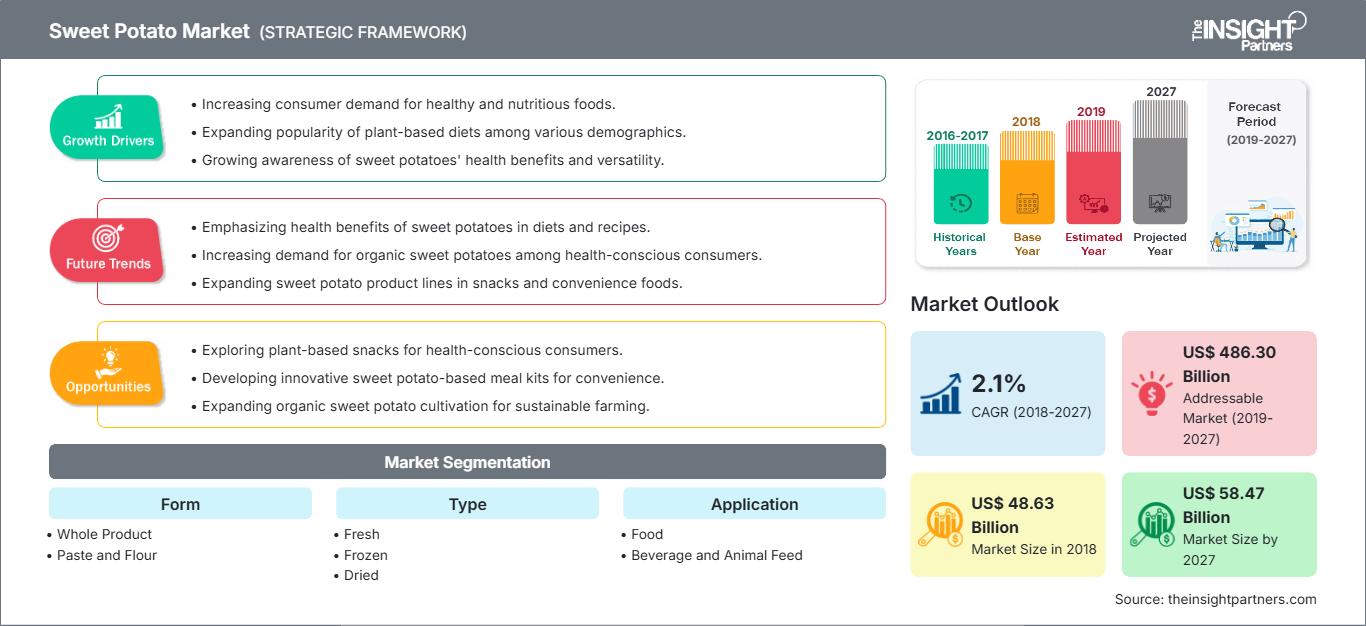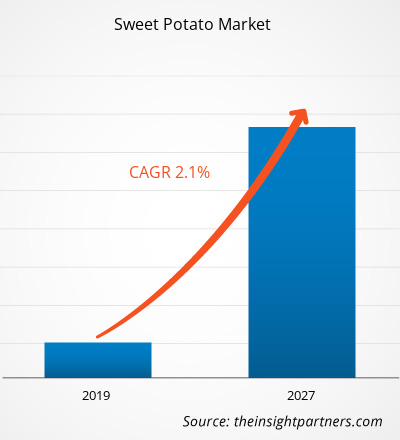Der globale Süßkartoffelmarkt machte im Jahr 2018 48.628,8 Mio. USD aus und wird im Prognosezeitraum 2019–2027 voraussichtlich mit einer durchschnittlichen jährlichen Wachstumsrate von 2,1 % wachsen und bis 2027 58.470,0 Mio. USD erreichen.
Der asiatisch-pazifische Raum hält den größten Marktanteil am globalen Süßkartoffelmarkt. Produktion und Verbrauch von Süßkartoffeln steigen rasant an, wobei China und der Rest des asiatisch-pazifischen Raums die wichtigsten Märkte für die Süßkartoffelindustrie sind. Der asiatisch-pazifische Raum hat sich zum größten Verbraucher und Exporteur von Süßkartoffeln entwickelt. Die Süßkartoffelproduktion hat in den letzten Jahren erheblich zur nationalen Wirtschaft im gesamten asiatisch-pazifischen Raum beigetragen. Der asiatisch-pazifische Markt ist durch die Präsenz von Akteuren wie Dole Food Company INC. und HJ Heinz Company Brands LLC gekennzeichnet. , Lamb Weston Holdings, INC., Nash Produce, The JR Simplot Company und andere.
Markteinblicke: Chancen für Landwirte im Nahen Osten und Afrika aufgrund des Süßkartoffelmangels in Nordamerika und Europa
Der Süßkartoffelkonsum steigt, da sie verschiedene gesundheitliche Vorteile bietet. Die Lebensmittel- und Getränkeunternehmen in Nordamerika und Europa haben innovative Süßkartoffelprodukte entwickelt, die eine großartige Kombination aus Geschmack und Nährwert bieten. Die Lebensmittel- und Getränkehersteller versuchen kontinuierlich, innovativere Produkte mit bekannten Zutaten auf den Markt zu bringen, um bei gesundheitsbewussten Verbrauchern Anklang zu finden. Die Hauptsorge Nordamerikas und Europas ist der Produktionsmangel bei Süßkartoffeln. Der niedrige Preis ist einer der Hauptgründe für die geringe Süßkartoffelproduktion in Nordamerika. Unsichere klimatische Bedingungen sind ein weiterer Grund für die geringe Süßkartoffelproduktion in Nordamerika und Ägypten. Die jüngsten Hurrikane und starken Regenfälle im Jahr 2018 in den USA waren ein wesentlicher Faktor, der die gesamte in dieser Saison angebaute Süßkartoffelmenge vernichtete. In Nordamerika ist eine steigende Nachfrage nach Süßkartoffeln zu verzeichnen, was den Bauern im Nahen Osten und in Afrika enorme Möglichkeiten eröffnet, ihre Ernte in diese Region zu exportieren.
Passen Sie diesen Bericht Ihren Anforderungen an
Sie erhalten kostenlos Anpassungen an jedem Bericht, einschließlich Teilen dieses Berichts oder einer Analyse auf Länderebene, eines Excel-Datenpakets sowie tolle Angebote und Rabatte für Start-ups und Universitäten.
Süßkartoffelmarkt: Strategische Einblicke

-
Holen Sie sich die wichtigsten Markttrends aus diesem Bericht.Dieses KOSTENLOSE Beispiel umfasst Datenanalysen, die von Markttrends bis hin zu Schätzungen und Prognosen reichen.
Die Hersteller der Lebensmittel- und Getränkeindustrie konzentrieren sich auf die wichtigsten Markttrends und Verbraucheranforderungen, um innovative Produkte zu entwickeln und den Umsatz ihrer gesamten Produktlinie zu steigern. Daher haben in den letzten Jahren mehrere Unternehmen innovative Süßkartoffelprodukte auf den Markt gebracht, die Verbrauchern gesunde Alternativen bieten. 2018 brachte Starbucks Japan einen knusprigen Süßkartoffel-Frappuccino und -Latte in limitierter Auflage auf den Markt, während die Campbell Soup Company ein neues veganes Süßkartoffelsaftgetränk auf den Markt brachte, um die steigende Nachfrage nach pflanzlichen Produkten zu befriedigen. 2018 kamen außerdem verschiedene andere Süßkartoffelprodukte wie Waffeln, Chips, Puffs, Sticks, Laibe und Riegel auf den Markt. Daher wird erwartet, dass die zunehmende Neigung zu pflanzlichen Produkten und die zunehmende Verwendung von Süßkartoffeln in verschiedenen Produkten den Süßkartoffelmarkt im Prognosezeitraum ankurbeln werden.
Form Insights
Auf Grundlage der Form wurde der globale Süßkartoffelmarkt in Vollprodukt, Paste und Mehl segmentiert. Im Segment Formen führte der Gesamtproduktmarkt den globalen Süßkartoffelmarkt an. Darüber hinaus wird erwartet, dass das Mehlsegment im Prognosezeitraum die höchste durchschnittliche jährliche Wachstumsrate (CAGR) verzeichnet. Als Gesamtprodukt wird die Süßkartoffel seit mehr als 8.000 Jahren angebaut. Sie ist eine reichhaltige Quelle für Stärke, Ballaststoffe und Nährstoffe wie Vitamin A. Der niedrige Fruktosegehalt der Süßkartoffel hat sich in der Getränkeindustrie bewährt und sie wird auch als Alternative zu braunem Zucker in verschiedenen Saftkonzentraten verwendet. Die Süßkartoffel ist in verschiedenen Farben erhältlich, beispielsweise Braun, Orange und Lila. Ihre ausgeprägte Farbe macht sie zu einer geeigneten Option für die Verwendung in verschiedenen Milchprodukten wie Käse und Butter. Dies stärkt den weltweiten Süßkartoffelmarkt zusätzlich.
Süßkartoffel
Regionale Einblicke in den SüßkartoffelmarktDie Analysten von The Insight Partners haben die regionalen Trends und Faktoren, die den Süßkartoffelmarkt im Prognosezeitraum beeinflussen, ausführlich erläutert. In diesem Abschnitt werden auch die Marktsegmente und die geografische Lage in Nordamerika, Europa, dem asiatisch-pazifischen Raum, dem Nahen Osten und Afrika sowie Süd- und Mittelamerika erörtert.
Umfang des Süßkartoffelmarktberichts
| Berichtsattribut | Einzelheiten |
|---|---|
| Marktgröße in 2018 | US$ 48.63 Billion |
| Marktgröße nach 2027 | US$ 58.47 Billion |
| Globale CAGR (2018 - 2027) | 2.1% |
| Historische Daten | 2016-2017 |
| Prognosezeitraum | 2019-2027 |
| Abgedeckte Segmente |
By Form
|
| Abgedeckte Regionen und Länder |
Nordamerika
|
| Marktführer und wichtige Unternehmensprofile |
|
Dichte der Akteure auf dem Süßkartoffelmarkt: Verständnis ihrer Auswirkungen auf die Geschäftsdynamik
Der Süßkartoffelmarkt wächst rasant, angetrieben von der steigenden Nachfrage der Endverbraucher. Diese Entwicklung ist auf Faktoren wie veränderte Verbraucherpräferenzen, technologische Fortschritte und ein stärkeres Bewusstsein für die Vorteile des Produkts zurückzuführen. Mit der steigenden Nachfrage erweitern Unternehmen ihr Angebot, entwickeln Innovationen, um den Bedürfnissen der Verbraucher gerecht zu werden, und nutzen neue Trends, was das Marktwachstum weiter ankurbelt.

- Holen Sie sich die Süßkartoffelmarkt Übersicht der wichtigsten Akteure
Der globale Süßkartoffelmarkt wurde nach Sorten segmentiert in frische, gefrorene, getrocknete und sonstige Sorten. Das Segment der frischen Sorten machte den größten Anteil am globalen Süßkartoffelmarkt aus. Frische Süßkartoffeln werden direkt vom Bauernhof geerntet. Frische Süßkartoffeln sind unverfälscht mit jeglichen Konservierungs- oder Düngemitteln. Sie sind sehr reich an Ballaststoffen, Stärke und Vitamin A. Bio-Süßkartoffeln gelten nicht als frisch, da sie mit verschiedenen Konservierungs- und Düngemitteln verfälscht sind. Diese Faktoren werden das Wachstum des Süßkartoffelmarktes im Prognosezeitraum voraussichtlich vorantreiben.
Fusionen und Übernahmen erwiesen sich als die am häufigsten angewandten Strategien auf dem globalen Süßkartoffelmarkt. Einige der jüngsten Entwicklungen auf dem globalen Süßkartoffelmarkt sind nachfolgend aufgeführt:
2019: Die Jackson Farming Company hat das Vertriebsteam von Wayne Bailey Produce übernommen und behalten, was dem Unternehmen dabei helfen soll, seine Präsenz in der Süßkartoffelbranche auszubauen.2019: Lamb Weston Holdings, Inc. schloss eine Vereinbarung zur Übernahme von Ready Meals Pty Ltd. ab. Letztere verkaufte bisher Tiefkühlkartoffelprodukte unter der Marke Harvest Choice.2018: Ham Farms beschloss, seine wichtigste Bio-Marke auf den Markt zu bringen, die lose und in 3-, 5- und 10-Pfund-Säcken erhältlich sein wird.
Globaler Süßkartoffelmarkt – nach Form
- Vollständiges Produkt
- Paste
- Mehl
Globaler Süßkartoffelmarkt – Nach Typ
- Frisch
- Gefroren
- Getrocknet
Globaler Süßkartoffelmarkt – Nach Anwendung
- Lebensmittel
- Getränke
- Tierfutter
Globaler Süßkartoffelmarkt – Nach Geografie
-
Nordamerika
- USA
- Mexiko
- Übriges Nordamerika
-
Europa
- Griechenland
- Portugal
- Italien
- Übriges Europa
-
Asien-Pazifik (APAC)
- Indonesien
- China
- Indien
- Japan
- Taiwan
- Übriger Asien-Pazifik-Raum
-
Naher Osten und Afrika (MEA)
- Afrika
- Ägypten
- Kenia
- Rest von MEA
-
Süd Amerika
- Brasilien
- Argentinien
- Rest von Südamerika (SAM)
Firmenprofile
- AV Thomas Produce
- Dole Food Company Inc.
- Ham Farms
- Jackson Farming Company
- Lamb Weston Holdings, Inc.
- McCain Foods Limited
- Nash Produce
- Simplot Food Group
- The Kraft Heinz Company
- Yantai China Pet Foods Co., Ltd
- Historische Analyse (2 Jahre), Basisjahr, Prognose (7 Jahre) mit CAGR
- PEST- und SWOT-Analyse
- Marktgröße Wert/Volumen – Global, Regional, Land
- Branchen- und Wettbewerbslandschaft
- Excel-Datensatz
Aktuelle Berichte
Erfahrungsberichte
Grund zum Kauf
- Fundierte Entscheidungsfindung
- Marktdynamik verstehen
- Wettbewerbsanalyse
- Kundeneinblicke
- Marktprognosen
- Risikominimierung
- Strategische Planung
- Investitionsbegründung
- Identifizierung neuer Märkte
- Verbesserung von Marketingstrategien
- Steigerung der Betriebseffizienz
- Anpassung an regulatorische Trends






















 Kostenlose Probe anfordern für - Süßkartoffelmarkt
Kostenlose Probe anfordern für - Süßkartoffelmarkt